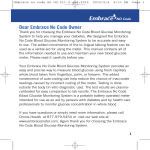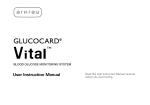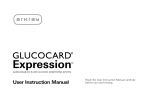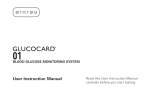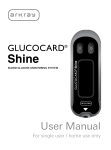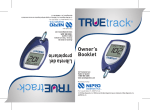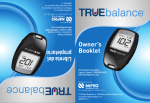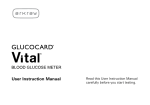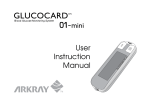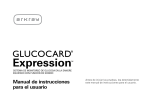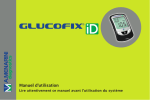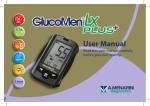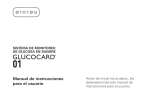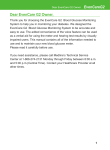Download User Instruction Manual
Transcript
User Instruction Manual Read this User Instruction Manual carefully before you start testing. TABLE OF CONTENTS Introduction . . . . . . . . . . . . . . . . . . . . . . . . . . . . . . . . . . . . . . . . . . . 4 Intended Use . . . . . . . . . . . . . . . . . . . . . . . . . . . . . . . . . . . . . . . . . . 5 The GLUCOCARD Expression System Includes. . . . . . . . . . . . . . . 7 Getting to Know the GLUCOCARD Expression Blood Glucose Meter. . 8 Meter Display Screen . . . . . . . . . . . . . . . . . . . . . . . . . . . . . . . . . . 10 The GLUCOCARD Expression Test Strip . . . . . . . . . . . . . . . . . . . . . 12 GLUCOCARD Expression Control Solution (Recommended). . . . 14 Setting Up Your GLUCOCARD Expression System . . . . . . . . . . . 15 The Set Up Screen . . . . . . . . . . . . . . . . . . . . . . . . . . . . . . . . . 15 Setting the Clock. . . . . . . . . . . . . . . . . . . . . . . . . . . . . . . . . . . 17 Setting the Alarms . . . . . . . . . . . . . . . . . . . . . . . . . . . . . . . . . 21 Voice and Beeper Function. . . . . . . . . . . . . . . . . . . . . . . . . . . 23 Voice Function Table . . . . . . . . . . . . . . . . . . . . . . . . . . . . . . . . . . . 26 Control Solution Testing. . . . . . . . . . . . . . . . . . . . . . . . . . . . . . . . 32 2 Performing a Control Solution Test. . . . . . . . . . . . . . . . . . . . . 33 Control Solution Trouble Shooting. . . . . . . . . . . . . . . . . . . . . 38 Testing Your Blood Glucose . . . . . . . . . . . . . . . . . . . . . . . . . . . . . 40 Preparing Your Lancing Device. . . . . . . . . . . . . . . . . . . . . . . . 41 Important Information on Alternate Site Testing (AST). . . . . . 43 Performing a Blood Glucose Test . . . . . . . . . . . . . . . . . . . . . . 45 Understanding Your Blood Glucose Test Results. . . . . . . . . . . . . 51 Viewing the Meter Memory . . . . . . . . . . . . . . . . . . . . . . . . . . . . . 53 Caring for the Meter . . . . . . . . . . . . . . . . . . . . . . . . . . . . . . . . . . . 58 Changing the Battery . . . . . . . . . . . . . . . . . . . . . . . . . . . . . . . 58 Cleaning the Meter . . . . . . . . . . . . . . . . . . . . . . . . . . . . . . . . . 59 Storage and Precautions. . . . . . . . . . . . . . . . . . . . . . . . . . . . . 60 Downloading Test Results to a Computer. . . . . . . . . . . . . . . . . . . 61 Solving Problems. . . . . . . . . . . . . . . . . . . . . . . . . . . . . . . . . . . . . . 61 Warranty. . . . . . . . . . . . . . . . . . . . . . . . . . . . . . . . . . . . . . . . . . . . 65 Specifications . . . . . . . . . . . . . . . . . . . . . . . . . . . . . . . . . . . . . . . . 66 Returns . . . . . . . . . . . . . . . . . . . . . . . . . . . . . . . . . . . . . . . . . . . . . 67 3 INTRODUCTION Thank you for choosing the GLUCOCARD Expression Blood Glucose Monitoring System to help you monitor your diabetes. We designed the GLUCOCARD Expression Blood Glucose Monitoring System to be accurate and easy to use. The added convenience of the bilingual voice feature can be used as a verbal aid for using the meter and hearing test results by visually impaired users. This manual contains all the information needed to use and maintain your new blood glucose meter. Please read carefully before use. If you have any questions, call Customer Service at 800.566.8558 (USA and Canada only). Contact your healthcare professional with questions if you are unable to reach Customer Service. 4 Intended Use The GLUCOCARD Expression Blood Glucose Monitoring System is intended for the quantitative measurement of glucose in fresh capillary whole blood samples drawn from the fingertips, forearm, or palm. Testing is done outside the body (In Vitro diagnostic use). The meter includes voice functionality to assist visually impaired users. It is intended for both lay use by people with diabetes and in a clinical setting by healthcare professionals, as an aid to monitoring levels in Diabetes Mellitus. It is not intended for the diagnosis or screening of diabetes or for neonatal use. 5 IMPORTANT: • Dehydration – Severe dehydration may lead to inaccurate blood glucose test result. If you suspect you are severely dehydrated, contact your healthcare professional immediately. 6 • Hematocrit range – A hematocrit range that is higher than 55% or lower than 30% can cause inaccurate blood glucose test results. • Not intended for use on neonates. THE GLUCOCARD EXPRESSION SYSTEM INCLUDES: • GLUCOCARD Expression Meter • User Instruction Manual • Carrying Case • Self-testing Log Book • May include Test Strips, Control Solution, and Lancing Device and/or Lancets 7 GETTING TO KNOW THE GLUCOCARD EXPRESSION BLOOD GLUCOSE METER Test Strip Port Insert test strip (see page 45) to turn on the meter. Meter Display Shows your blood glucose test results, memory values, averages, and other messages. Enter ( ) and buttons Press and hold Enter ( ) for 2 seconds to turn on or off the Meter, or press Enter ( ) to go into setup mode when not testing (see page 15) < 8 < Press or to enter control mode with test strip inserted (see page 32), during meter setup (see page 15), or to navigate the stored test values and averages (see page 53) Battery Compartment Holds two AAA batteries Data Port Connect an ARKRAY data cable* here to send data to a PC. *Purchased separately 9 METER DISPLAY SCREEN BATTERY Appears when batteries need to be changed (see page 58). CABLE Indicates the meter is in data transfer mode to PC. mem MEM Indicates the number in the meter display is a stored test value (see page 53). ALARM Indicates alarm has been set (see page 21). CTL This icon indicates a control solution test (see page 32) or the stored value is a control solution result (see page 57). 10 mg /dL ctl DAY AVG AM PM BEEPER Set sound volume (see page 23). mem TEMPERATURE Appears when meter is outside of temperature range (50˚F~104˚F). CLOCK Indicates the meter is ready to set up time and date (see page 17). mg /dL ctl DAY AVG AM PM VOICE Indicates the voice feature is turned on (see page 23). UNITS Unit of measurement for your blood glucose is mg/dL. BLOOD DROP and ARROW Indicate the meter is ready for testing (see page 45). Displays the date, time, am/pm (in 24-hours format, see page 19), or type of day averages (7, 14, or 30, see page 53) 11 The GLUCOCARD EXPRESSION Test Strip Contact Points Insert this end to the test strip port on the meter. Sampling End Apply blood or control solution here. The GLUCOCARD Expression Test Strips require a small blood sample to quickly test glucose in fresh capillary whole blood. The test results are plasma-calibrated for easy comparison to lab results, however results may be 10% to 15% higher than results obtained from whole-blood referenced blood glucose assays. The test strip is also equipped with under-fill detection to alert you when there is not enough blood to perform a test. This ensures that every reading is accurate and meaningful. 12 IMPORTANT: • Immediately close the test strip bottle cap tightly after each use. Keep the unused test strips in the original bottle. DO NOT store any test strips outside the bottle while not in use. • DO NOT reuse test strips. Test strips are for single use only. • Carefully discard used test strips and lancets in proper waste containers. 13 GLUCOCARD EXPRESSION Control Solution (Recommended) GLUCOCARD Expression Control Solution is the standard glucose concentration solution required to perform a Glucose Control Solution Test. (See Control Solution Testing, page 32). GLUCOCARD Expression Control Solution is available in 2 levels. GLUCOCARD Expression Control Solution Level 1 (L1) helps you validate the performance of your system for a normal range blood glucose reading. Level 2 (L2) solution helps you validate your system performance for a high range blood glucose reading. Run a control test to make sure the Test Strips and Meter are working together properly, to practice testing procedure, and after opening a new bottle of GLUCOCARD Expression Test Strips. Call your local supplier or pharmacy to order control solution. If they do not stock the product, please call Order Services at 1-800-818-8877 (USA and Canada). 14 Setting Up Your GLUCOCARD expression System The Setup Screen mem The Setup Screen of the GLUCOCARD Expression meter lets you take advantage of the GLUCOCARD functions of this meter. To access the Setup Screen: Step 1: PM Press and hold Enter ( ) to turn on meter. Step 2: Press Enter ( ) to enter into the Setup Screen. Step 3: Simply use < > buttons to navigate to the desired function icon, and press the Enter ( ) button to enter the function when the icon is flashing. Step 4: Navigate to End at the display screen to exit the Setup Screen. The Meter will also announce each function when the voice feature is turned on. 15 ������Press Enter ( ) to enter Memory Recall to retrieve stored results. Your meter stores up to 300 test results with date and time (see page 53). mem ��������Press Enter ( ) to enter PC Link Mode for data transfer onto a PC. ��������Press Enter ( ) to enter Time and Date Setup (see page 17). ��������Press Enter ( ) to enter Alarm Setup (see page 21). Your meter has 3 alarm settings. ��������Press Enter ( ) to enter Volume Setup (see page 24). ��������Press Enter ( ) to enter Language Selection (see page 25). End�������Exit Setup Screen and return to testing. 16 PM Setting the Clock You will need: • Your GLUCOCARD Expression Meter NOTE If date and time on the GLUCOCARD Expression Meter has not been set, test or control result will not be stored in memory. Step 1: Press and hold Enter ( ) to turn on the meter. < < Step 2: Press Enter ( ) to go into the setup screen, then press < or > until starts to flash. If the voice function is on, the meter will say, “Set date and time.” Press Enter ( ) to enter clock setup. 17 Step 3: Set the Year. The current year will flash. If the voice function is on, the meter will say, “Set Year.” Press < or > to select the correct year. Press Enter ( ) to confirm your choice. The screen advances to set the month. PM Step 4: Set the Month. The current month will flash. If the voice function is on, the meter will say, “Set Month.” Press < or > to select the correct month. Press Enter ( ) to confirm your choice. The screen advances to set the date. PM Step 5: Set the Date. The current date will flash. Press < or > to select the correct day. If the voice function is on, the meter will say, “Set Day.” Press Enter ( ) to confirm your choice. The screen advances to the time format setting. 18 PM Step 6: Set the Time Format to 12-hour or 24-hour: The current time format will flash. Press < or > to select either 12-hour format or 24-hour format. Press Enter ( ) to confirm your choice. The screen advances to the hour setting. PM Step 7: Set the Hour. The current hour will flash. If the voice function is on, the meter will say, “Set Hour.” Press < or > to select the correct hour. Press Enter ( ) to confirm your choice. The screen advances to the minutes setting. PM Step 8: Set the Minute. The current minutes will flash. If the voice function is on, the meter will say, “Set Minutes.” Press < or > to select the correct minute. Press Enter ( ) to confirm your choice and finish setting the clock. PM 19 NOTE: • Anytime during set up, inserting a GLUCOCARD Expression Test Strip will begin testing. Any changes made so far will be stored. • You may need to reset time after changing batteries. After date and time has been set, the meter will announce the date and time if the voice feature is on. Begin testing by inserting a GLUCOCARD Expression Test Strip (see page 40, Testing Your Blood Glucose), or press and hold Enter ( ) to turn the meter off. See the next section to set up the alarm feature on your meter. 20 Setting the Alarms You can set up to three alarms on the GLUCOCARD Expression meter. You must set the clock before the alarms can be set. When an alarm sounds, the meter turns on, and a melody sounds for 30 seconds. Pressing Enter ( ) or inserting a test strip will silence the alarm. You can set one, two, or all three alarms. You will need: • Your GLUCOCARD Expression Meter Step 1: Press and hold Enter ( Step 2: Press Enter ( ) to turn on the meter. < < ) to enter setup screen. Step 3: starts to flash. If the voice function is on, the Press < or > until meter will say, “Set Testing Alarm.” Press Enter ( ) to enter alarm setting. 21 Step 4: The display screen will indicate alarm 1 status (the default is OFF). You can turn alarm on or off by pressing < or >. Step 5: Press Enter ( ) and the hour will flash. Press < or > to select the hour. Press Enter ( ) to confirm your choice and the screen advances to the minute setting. PM Step 6: The current minutes will flash. Press < or > to select the correct minute. Press Enter ( ) to confirm your choice. The screen advances to the alarm 2 setting. Step 7: To set alarm 2 and alarm 3 following steps 4 through 6. After you have finished setting up alarm 3, press Enter ( to exit alarm setup. PM ) PM 22 NOTE: • Alarm will not sound during testing. • Alarm will follow the time format (12-hour or 24-hour) you choose when setting up the clock. • Alarm settings will not be erased when changing batteries. Begin testing by inserting a GLUCOCARD Expression Test Strip (see page 40, Testing Your Blood Glucose), or press and hold Enter ( ) to turn off the meter, or see the next section on how to set up the voice feature on your meter. Voice and Beeper Function Your meter has a bilingual voice function that can be used as a verbal aid for using the meter and hearing test results. The default setting for the voice function is on, and can be turned off to conserve battery power. When the voice function is off, the meter will beep to alert you of important messages. You will need: Your GLUCOCARD Expression Meter 23 Setting Volume Step 1: Press and hold Enter ( < < ) to turn on the meter. Step 2: Press Enter ( ) to go into setup screen. Press < or > until flash. Press Enter ( ) to enter volume setting. starts to Step 3: The screen displays the current sound volume (default is 2). Press < or > to adjust the sound volume from 1 (lowest) to 5 (highest). A melody will sound according to the sound volume you have selected. Setting to 0 will turn off the voice function. When the voice is turned off, the meter will beep to alert you of important messages. Once you have determined the suitable volume, press Enter ( ) to exit volume setting. 24 PM Language Selection Step 1: Press and hold Enter ( Step 2: Press Enter ( < < ) to turn on the meter. ) to enter setup screen. Step 3: Press < or > until starts to flash. If the voice function is on, the meter will announce “Language Selection.” Step 4: Press Enter ( ) to enter the language set up. English is the default language (1 on the display screen) and is announced. Press < or > to select Spanish (2 on the display screen). Press Enter ( ) when you have finished selecting the language and exit language selection. PM 25 NOTE: • Any time during set up you can insert a GLUCOCARD Expression Test Strip and begin testing. Any changes made so far are stored. • Your choice of language and volume settings will not be erased when changing batteries. Begin testing by inserting a GLUCOCARD Expression Blood Glucose Test Strip (see page 40, Testing Your Blood Glucose) or press and hold Enter ( ) to turn off the meter. Voice Function Table The voice function can be used as an aid for you to hear the test results and use the meter. The following table lists WHEN the meter will speak and WHAT the meter will say when voice function is turned on. 26 WHEN the meter will speak... WHAT the meter will say... Turned on Melody Prompt user to insert test strip “Please insert test strip” Test strip is inserted and the meter is ready to test (with flashing arrow and blood drop) “Blood glucose test. Please apply blood onto the test strip” Blood Glucose test is completed and the result is shown on screen “Your blood glucose reading is (number) milligrams per deciliter” Blood Glucose test result is BELOW the measurement range of 20 mg/dL “Your blood glucose reading is below 20 mg/dL” “Your blood glucose reading is Blood Glucose test result is ABOVE the measurement range of 600 mg/dL above 600mg/dL” Temperature is out of range (between 50˚F~104˚F) “Temperature is out of range” When the meter is turned off Melody 27 Voice Function: Control Solution and Blood Glucose Testing (See page 32 - Control Solution Testing and page 40 - Testing Your Blood Glucose) Insert the test strip and press < or > (ctl appears next to the test strip icon) “L1 control solution test. Please apply control solution onto the test strip.” < < < 28 < < “Blood glucose test. Please apply blood onto the test strip.” < “L2 control solution test. Please apply control solution.” Voice Function: The Setup Screen (See page 15 - Setting Up Your Glucocard Expression System) Pressing Enter ( ) to enter setup screen (after the meter has been turned on) “End Function Mode” < < < < < < “Memory Recall” “PC Link”* < < *This function is not available yet “Set Date and Time” “Set Testing Alarm” < < < < < < “Language Selection” “Set Sound Volume” 29 Voice Function: Setting the Clock WHEN the meter will speak... WHAT the meter will say... During date and time setup, setting up the year “Set Year” During date and time setup, setting up the month “Set Month” During date and time setup, setting up the date “Set Day” During time format setup, setting up the time format “Set 12 Hour, Set 24 Hour” During date and time setup, setting up the hour “Set Hour” During date and time setup, setting up the minutes “Set Minutes” After finish setting up date and time “The date and time is (year) (month) (date) (hour) (minutes)” 30 Voice Function: Setting the Alarms WHEN the meter will speak... WHAT the meter will say... Setting alarm 1, 2, or 3 “Set Alarm (number)” When sending data to PC “Sending data to PC” Finish sending data to PC “Data transmission complete” Voice Function: Other warning messages (See page 61 - Solving Problems) WHEN the meter will speak... WHAT the meter will say... Meter date and time has not been set “Please set date and time” Meter failure “Error 1 meter failure” Used test strip “Error 3 used test strip” Not enough blood or control solution “Error 4 not enough sample” 31 Control Solution Testing The purpose of the control solution testing is to make sure the GLUCOCARD Expression meter and the GLUCOCARD Expression Test Strip is working properly. You should perform control solution testing when: • Using the meter for the first time • Using a new bottle of GLUCOCARD Expression Test Strips • You left the test strip bottle cap open • You dropped the meter • You suspect your meter and test strips are not working properly • The blood glucose test results do not reflect how you feel • You want to practice the testing procedure Call your local supplier or pharmacy to order control solution. If they do not stock it, call ARKRAY Order Services at 800.818.8877 (USA and Canada only). 32 Performing a Control Solution Test IMPORTANT: • Use only the GLUCOCARD Expression Control Solution with the GLUCOCARD Expression Test Strips. Other brands of control solution will produce inaccurate results. • Always check the expiration date. DO NOT use control solution if it is expired. • DO NOT FREEZE. Store the control solution at room temperature. You will need: • GLUCOCARD Expression Control Solution (Level 1 or Level 2) • Your GLUCOCARD Expression meter • A new GLUCOCARD Expression test strip Step 1: Remove a GLUCOCARD Expression Test Strip from the test strip bottle. Close the bottle cap immediately. Insert the test strip to turn on the meter. 33 IMPORTANT: • Check the expiration date printed on the test strip bottle and its package. Do not use expired test strips. • Use test strip immediately after removing from the bottle. • Do not use wet or damaged test strips. • Keep away from direct sunlight and heat. Store the test strip bottle in a dry, cool place. • Record the “date opened” on the bottle label. Discard the bottle and any remaining test strips after 6 months from date of opening. • Test under the temperature range of 50˚F to 104˚F. Your meter will not work outside of this range. • Must insert test strip into the test strip port. • Must see a flashing blood drop icon when the test strip has been inserted into the test strip port. 34 Step 2: Wait until the flashing blood drop and arrow icons appear on the meter display screen. The meter will also announce, “Please apply blood onto the test strip” if you have the voice feature turned on. Press > to enter L1 control solution testing. ctl mo /dL Step 3: icon will appear next to the test strip icon and L1 will appear on the meter display screen. The meter will also announce “L1 control solution test, please apply control solution onto the test strip.” If you decide not to do a control solution test, Press < until disappears from the meter display. PM Step 4: Squeeze a drop of control solution onto a clean, dry, non-absorbent surface. Do not apply control solution to the test strip directly from the bottle. Replace the cap on the control solution bottle immediately after use. 35 < < Step 5: Gently touch the drop of the control solution to the tip of the test strip. The meter will beep indicating it has received the control solution. Step 6: The screen will start to count down. After 6 seconds, the control test result will appear on the meter display screen. Step 7: Compare the reading on the screen to the Level 1 range printed on the test strip bottle or its package. If the reading falls outside the Level 1 range printed on the test strip bottle or its package, see Control Solution Trouble Shooting, on page 38. PM Level 1: 53 - 79 Level 2: 135 - 203 36 NOTE: • Control solution test results will be stored into the meter memory and indicated by ctl icon. • Control solution test results will not be used for calculating averages. Step 8: Remove the used test strip. The meter will automatically turn off. Discard the used test strip into a proper waste container. IMPORTANT: Do not re-use Test Strips. Follow steps 3 through 8 to complete a Level 2 control solution test and compare the result with the Level 2 range printed on the test strip bottle. 37 Control Solution Trouble Shooting If your control solution test is out of range (too high or too low), it may be caused by the following: Possible Causes • Wrong brand of Control Solution used • Control solution not at room temperature • Expired or contaminated control solution or damaged test strip. 38 What you can do... • Make sure you are using GLUCOCARD Expression Control Solution. • Make sure the testing environment is between 50˚F to 104˚F. • Check the expiration and open bottle date on both the control solution and test strips. Repeat test using a new test strip. If the result is still out of range, use a new bottle of control solution and retest. Possible Causes • Meter malfunction What you can do... • If problem persists, Please call Customer Service at 1-800-566-8558 (USA and Canada only). Contact your diabetes healthcare professional if you cannot reach Customer Service. 39 Testing Your Blood Glucose You will need: • Your GLUCOCARD Expression meter • A new GLUCOCARD Expression test strip • Lancing device with a clean, unused lancet (or safety lancets) • Clear cap (lancing device) for Alternate Site Testing (AST) on palm and forearm Before you begin, make sure: • The meter has been set up properly and you’ve completed a control test. See Setting Up Your GLUCOCARD Expression System on page 15, and Control Solution Testing on page 32 for details. • Wash your hands and the testing site thoroughly with soap and warm water, dry well. • You are testing in an area between the temperature ranges of 50˚F~104˚F. NOTE: Your meter will not test outside of this range and will display a thermometer icon with verbal indication if the voice feature is turned on. Move the meter into an area that is between 50˚F~104˚F, and let sit for 10 to 15 minutes before testing again. 40 Preparing Your Lancing Device Step 1: Remove the adjustable cap by twisting the cap off the lancing device and insert the lancet by pushing down firmly until lancet is fully seated. Step 2: Twist the protective cover off the lancet. Attach the adjustable cap by twisting clockwise onto the lancing device. NOTE: • For fingertip testing, use the white adjustable cap. • For alternate site testing on palm and forearm, use the clear adjustable cap. 41 Step 3: Adjust the puncture setting on the adjustable cap for the puncture depth level (1 is the lightest and 5 is the deepest). Step 4: With one hand holding the adjustable cap, pull back the lancing device with your other hand until you hear a click. The lancing device is now ready for blood sampling. IMPORTANT: Use a new sterile lancet every time you test to avoid cross contamination. If alcohol wipes are used to cleanse the fingers, make sure the area is dry before the blood sample is obtained. 42 Important Information on Alternate Site Testing (AST) The GLUCOCARD Expression Blood Glucose Monitoring System can test blood glucose from areas other than your fingertip such as palm and forearm (alternate site testing, or AST). Alternate site testing can be less painful than fingertip testing, because of the physiological differences between your fingertip, palm and forearm (1); alternate site test results may be significantly different than results from fingertip testing under certain conditions. You should consult with your doctor or healthcare professional before using an alternate site to test. DO AST ONLY in the following intervals: • In a pre-meal or fasting state (more than 2 hours since the last meal) • 2 hours or more after taking insulin. • 2 hours or more after exercise. 43 Alternate Site Testing SHOULD NOT be used when: • You are experiencing Hypoglycemic unawareness (unable to tell if you have low blood sugar) • Within 2 hours of a meal, exercise, or medication • You will be operating machinery or driving a car. • You are sick • You think your blood glucose is low. • Your AST results do not match the way you feel. • You are testing for hyperglycemia. • Your routine glucose results are often fluctuating. • If you are pregnant. NOTE: • Rubbing forearm until warm before lancing will help minimize the difference between fingertip and AST results.The palm (at the base of the thumb) does not require rubbing before testing. • If results from alternate site testing do not agree with how you feel, repeat test using fingertip testing. 1. Jungheim K., Koschinsky T.: “Risky delay of hypoglycemia detection by glucose monitoring at the arm.” Diabetes Care 2001:24(7):1303-04. 44 Performing a Blood Glucose Test Step 1: Remove a GLUCOCARD Expression test strip from the test strip bottle. Close the bottle cap immediately. Insert the test strip to turn on the meter. IMPORTANT: • Check the expiration date printed on the test strip bottle and its package. Do not use expired test strips. • Use test strip immediately after removing from the bottle. • Do not use wet or damaged test strips. • Keep away from direct sunlight and heat. Store the test strip bottle in a dry, cool place. • Record the “date opened” on the bottle label. Discard the bottle and any remaining test strips after 6 months from date of opening. • Must insert test strip into the test strip port. • Must see a flashing blood drop icon when the test strip has been inserted into the test strip port. 45 Step 2: A flashing blood drop and arrow icon appears on the meter display screen. The meter will announce, “Please apply blood onto the test strip” if you have the voice feature turned on. Step 3: Obtain blood sample. For Fingertip Testing: Hold the lancing device (use the white adjustable cap) against the side of your fingertip and press the release button. 46 mo /dL PM TIP: • Gently massage your hand and finger toward the puncture site to form a drop of blood (approximate size ). Do not “milk,” or squeeze around the puncture site. • Lance the side of your fingertip to avoid soreness. To avoid calluses, choose a different lancing site each time. For Testing on Palm and Forearm: Hold the lancing device (use the clear adjustable cap) against the test site (base of palm or forearm). Avoid a test site that has veins, moles, excessive hair, or bone. Press the lancing device firmly against the test site and press the release button, hold lancing device in place. 47 For forearm test sites, apply and release pressure (“pump”) for a few seconds while keeping the lancing device in constant contact with the skin. Palm testing (at the base of the thumb) does not require pumping. When the blood drop is large enough (approximate size ), lift the lancing device straight up without smearing the blood drop. NOTE: • Rubbing forearm until warm before lancing will help minimize the difference between fingertip and AST test results. The palm (at the base of the thumb) does not require rubbing before testing. • If results from alternate site testing do not agree with how you feel, use fingertip testing. 48 < Step 4: Gently bring the test strip to the drop of blood at a slight angle. The test strip acts like a straw to pull the blood in. Keep the test strip in the blood drop until the meter beeps to indicate the test strip has enough blood. < Step 5: The screen will start to count down. After 6 seconds, your glucose test result will appear on the meter display screen and announce verbally if you have the voice feature turned on. Your test result will be automatically stored into the meter memory. PM 49 CAUTION: • If you see “HI” or “LO” displayed, your blood glucose level may be above 600 mg/dL or below 20 mg/dL. Test again using fingertip testing, DO NOT test on forearm. If you receive the same result, call your physician or healthcare professional immediately. Step 6: Remove the used test strip into proper waste container. The meter will automatically shut off. Step 7: Remove the used lancet from your lancing device according to instructions and discard into proper waste container. IMPORTANT: • You should consult your healthcare provider for instructions on how to properly dispose of used test strip. 50 Understanding Your Blood Glucose Test Results Blood glucose values vary depending on food intake, medication, health, stress, and exercise. The ideal range for adults with and without diabetes1: Normal and Target Blood Glucose Ranges Normal Blood Glucose Levels in People Who Do Not Have Diabetes Upon waking—fasting 70 to 99 mg/dL After meals 70 to 140 mg/dL Target Blood Glucose Levels in People Who Have Diabetes Before meals 70 to 130 mg/dL 1 to 2 hours after the start of a meal below 180 mg/dL It is important to consult with your physician or healthcare professional to determine an appropriate target range for you. High or Low Blood Glucose Readings If the meter displays results that are HI or LO, or you get a result that is more than 250 mg/dL or below 50 mg/dL AND you feel ill: • Treat your diabetes according to the instruction from your doctor and/or consult your healthcare provider. 51 If the meter displays results that are “HI” or “LO,” or you get a result that is more than 250 mg/dL or below 50 mg/dL AND you DO NOT feel ill: • Test your meter with a control solution, refer to page 32, Control Solution Testing. • Test again using fingertip testing. If you still get a high or low reading, contact your healthcare professional. NOTE: • Inaccurate results may occur in severely hypotensive individuals or patients in shock. • Inaccurate low results may occur for individuals experiencing a hyperglycemic-hyperosmolar state, with or without ketosis. • Critically ill patients should not be tested with blood glucose meters. Reference: 1. American Diabetes Association. Standards of Medical Care in Diabetes—2008. Diabetes Care. 2008;31:S12–S54. 52 Viewing the Meter Memory Your GLUCOCARD Expression meter automatically stores up to 300 test and control results with date and time. The meter also provides 7, 14, and 30 day averaging to help track your blood glucose trends. You must set the date and time on your meter to use the memory and day averaging function (see Setting Up Your GLUCOCARD Expression System on page 15). The meter will not store into memory test or control results if the date and time are not set. Viewing Stored Readings and 7, 14, and 30 Day Average from Memory You will need: • Your GLUCOCARD Expression meter 53 Step 1: Press and hold Enter ( Step 2: Press Enter ( ) to turn on the meter. ) to enter setup screen. Step 3: Press < or > until starts to flash. If the voice function is turned on, the meter will say “memory recall.” Press Enter ( ) to enter. mem will appear at the upper left corner of the display screen together with your most recent test result. Press < to see the next result, and the next, and so on. Holding < will flash through the test results. mem PM 54 nil will appear on the display screen after the last recorded test result if less then 300 readings are stored . You can press > to go back viewing from the oldest to the most recent readings. mem mem mem mg /dL mg /dL PM PM Step 4: When you reach the most recent test result, continue to press > to start viewing day averages. The meter will display the 7 day average, press > again to see the 14 day average, and press > again to see the 30 day average. 55 The number of results included in the average is shown right next to the icon. Control solution results are not included in the day average calculations. mem mem mem mg/dL DAY AVG 56 mg /dL mg/dL DAY AVG DAY AVG NOTE: • Control testing results are flagged by on the bottom left corner of the display screen in addition to . • When the meter memory is blank, the display screen will show nil. • When there is no day average data available, the display screen will show 4 dashes. • If the meter memory is full, adding a new test result will cause the oldest to be deleted. • Stored test results and day averages will not be erased when changing batteries. • You can begin testing anytime by inserting a test strip. 57 Caring for the Meter Caring for your GLUCOCARD Expression meter is easy. Follow these simple guidelines to keep your meter working properly. Changing the Battery Batteries need to be changed when the display. icon appears on the meter Materials you will need: • Two Alkaline AAA Batteries • Your GLUCOCARD Expression Meter Step 1: Press firmly on the battery cover and slide in the direction of the arrow. 58 Step 2: Insert new batteries . Slide the battery cover back into the meter firmly. NOTE: • Meter will prompt you to reconfirm the date and time when turned on. See page 17 for Setting the Clock. • The date, stored results, alarm settings, volume setting, and language choice remain in memory when the batteries are changed. Cleaning the Meter • If the meter is dirty, use a moist (NOT WET) lint-free cloth dampened with a mild detergent. • Do not allow water inside the meter or hold under running water. • Do not use glass or household cleaners on the meter. • Do not clean the test strip holder. 59 Storage and Precautions • Handle the meter with care- severe shock, such as dropping the meter, could damage the electronics. • The meter and test strips are designed to be used within the temperature range 50˚F to 104˚F. • Avoid leaving the meter in extremely hot or cold places, such as near a heat source or in an extremely hot or cold car. • Do not store or use the meter or test strips in high humidity levels, such as a bathroom or kitchen. • Always close the bottle cap immediately after removing a test strip and make sure to close tightly. • Do not take the meter apart. Doing so will void the warranty. If you have any questions, call Customer Service at 800.566.8558 (USA and Canada only). Contact your healthcare professional with questions if you are unable to reach Customer Service. 60 Downloading Test Results to a Computer We offer a diabetes management software system to help you download your test results to a computer. For more information on ARKRAY diabetes data management software, call ARKRAY Customer Service at 800.566.8558 (24 hours a day, 7 days a week, USA and Canada only). Solving Problems Please first read this section. If you have questions, call Customer Service at 800.566.8558 (USA and Canada only). Contact your healthcare professional with questions if you are unable to reach Customer Service. If any part of the display screen is missing when the meter is turned on, call Customer Service at 800.566.8558 (USA and Canada only). 61 What you see 62 What meter says What it means What you should do “Error 1 Meter Failure” The meter electronics or test strip is damaged • Remove the battery and turn on the meter. • Remove the test strip and insert a new test strip. • If problem persists, call us at 1-800-566-8558 (USA and Canada only). “Error 3 used test strip” Used or damaged test strip • Repeat the test with a new test strip. Remember to add sample until you see the prompt on the display screen or the meter verbally prompts you to add sample. “Error 4 not enough sample” • Remove the test strip and repeat the test with a new test strip. (See Testing Your Blood Glucose on page 40.) Not enough sample on the test strip to start What you see mg /dL PM What meter says What it means What you should do Low battery Batteries are low Change the battery (see page 58, Changing the Battery). “Temperature is out of range” Temperature is out of range Move the meter into an area that is between 50˚F~104˚F, and allow 10 to 15 minutes to reach the new temperature. “Your blood glucose reading is above 600 mg/dL.” Test result is higher than 600 mg/dL Wash and dry your hands and repeat the test on your fingertip with a new test strip. If the result is still “HI,” contact your physician or healthcare professional immediately. 63 What you see What meter says What it means “Your blood glucose reading is below 20 mg/dL.” Test result is lower than 20 mg/dL Wash and dry your hands and repeat the test on your fingertip with a new test strip. If the result is still “LO,” contact your physician or healthcare professional immediately. NA There are no stored results in the meter Check if the date and time on your meter is set. (See Setting Up Your GLUCOCARD Expression System on page 15 and/or Testing Your Blood Glucose on page 40.) mg /dL PM mem 64 What you should do Warranty You are a valued customer of ARKRAY. It is important to us that you are completely satisfied with your GLUCOCARD Expression blood glucose meter. ARKRAY warrants your GLUCOCARD Expression blood glucose meter will be free from defects in materials and workmanship for a period of five years from the date of the original purchase. If during this time the meter does not work properly because of a defect in materials or workmanship, ARKRAY agrees to replace or repair, free of charge any and all parts proven to be defective and subject to warranty. This warranty is in lieu of all other warranties, expressed or implied, including any implied warranty of merchantability or fitness for any purpose, other than stated herein. This warranty does not apply to the performance of the GLUCOCARD Expression blood glucose meter that has been damaged by accident or has been altered, misused, tampered with, or abused in any way. This warranty only applies to the original purchaser of the meter and/or its agents 65 Specifications Test Strips: GLUCOCARD Expression Test Strips Test Range: 20 - 600 mg/dL Calibration: Plasma Test Time: 6 Seconds Sample Size: Larger than 1µL Hematocrit Range: 30-55% Display Type: Large LCD screen Memory: 300 blood test results with date and time Result Averaging: 7, 14, and 30 days averaging Dimension: 93L x 58W x 20.5H (mm) Weight:79g Battery: 2 Alkaline AAA Batteries Battery Life: 1000 tests of continuous use or 1 year Automatic Power-off: After 2 minutes of non-use Operating Temperature: 50˚F to 104˚F. Relative Humidity: Less than 85% Storage Condition: Meter at 39˚F ~ 122˚F Test Strips at 39˚F ~ 86˚F For additional information, refer to the GLUCOCARD Expression Test Strip insert. 66 Returns You must contact ARKRAY Customer Service at 800.566.8558 before returning your meter. You will be instructed how to return the meter to ARKRAY. Returned meters without this authorization will not be accepted. 67 TEL 800.566.8558 FAX 952.646.3110 www.arkrayusa.com ©2011 ARKRAY, Inc. 68 P/N 7888-01 Rev 3/12 65070000093




































































